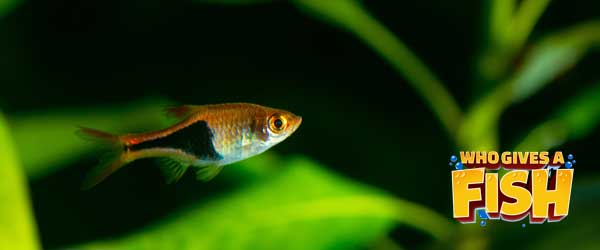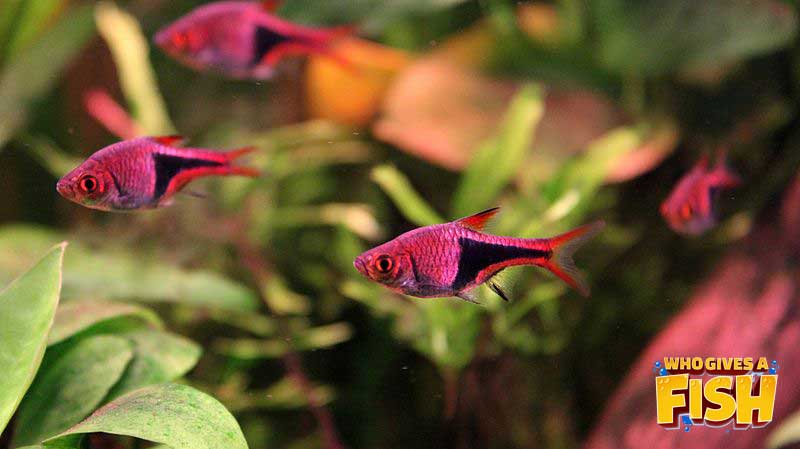Harlequin Rasbora
The Harlequin Rasbora, Trigonostigma heteromorpha, is a prominent aquarium fish that belongs to the Cyprinidae family.
This particular fish species is indigenous to Singapore, Sumatra, Southern Thailand and Malaysia. It inhabits water bodies and streams that are based in peat swamp forests. They are usually a black water fish that prefers soft and acidic water.
- Experience Level: Beginner providing tank has cycled
- Hardiness: Moderate
- Minimum Tank Size: 30 G (115 L)
- Maximum Size: 2 in (5 cm)
- Temperament: Peaceful
- Temperature: 72°F – 80°F (22°C – 27°C)
- pH Range: 6.0 – 8.0
- Water Hardness: 5 – 12 dH
- Diet: Omnivore
Table of Contents
Introduction
Aquarium Setup
Feeding
Breeding and Social
The harlequin rasbora has a capsule-shaped body with a profoundly forked caudal fin. The body is varied in color, which can range from a bright red or a pale pink, to a copper orange toward the top and bottom with a noticeable blue tint.
The back half of the body bears a broad and roughly triangular black marking which tapers off towards the end of the caudal peduncle. The pectoral fins are placed immediately behind the operculum or gill cover, while the pelvic fins are situated along the ventral part of the body.
The anal, dorsal, pelvic and caudal fins have a red tinge to them, with the most red color concentration in the outermost rays. They tend to swim in schools and are well-known as micro-predators which generally feed on smaller insects, zooplankton, worms and crustaceans. It can grow up to 5 cm in length and can live up to 6 years.
The Harlequin Rasbora was first described by Duncker in 1904. It is distributed in Southeast Asia on the Malay Peninsula throughout western Malaysia, southern Thailand and Singapore. It is also known to occur on the island of Bintan in Riau Island province, Sumatra. It is also known as Red Rasbora, Harlequin Fish and Harlequin. It is sometimes called Black Harlequin Rasbora, Blue Harlequin Rasbora and Gold Harlequin Rasbora due to their color variations.
Aquarium Setup
The Harlequin Rasbora is a flexible fish in the aquarium owed to their rugged and tough body. It is a shoaling fish that should ideally be kept with at least six individuals or more. It is a placid aquarium fish that should also be kept with other equivalently sized fish including small characins, danios, Otocinclus catfhishes, assorted small barbs and other small rasboras and Corydoras catfish. It needs at least a 20 gallon tank with decent water quality. Water pH should be ranged between 5.5-8.0 while water density should be varied between zero to 12 dGH. The water temperature should be sustained between 73.0 to 82.0° F. It is a black water species that prefers filtered water via peats.
The Harlequin rasbora prefers dull light and a few floating plants such as Aponogeton and Cryptocoryne species on the surface in an open area. Up to 50% of the tank water should ideally be replaced once a month. If the tank is densely stocked, around 20-25% should be replaced weekly, or every other week. A darkened bottom substrate is recommended. The substrate should also be vacuumed during water changes to avoid the accumulation of waste.
Harlequin Rasbora Aquarium Guide
- Minimum Tank Size: 30 G (115 L) although 50 G is more suitable for schools
- pH Range: 6.0 – 8.0
- Water Hardness: 5 -12 dGH
- Temperature: 72°F – 80°F (22°C – 27°C)
- Lighting: Low to moderate.
- Substrate: Any.
- Brackish: No
- Water Flow: Low to moderate
- Tank Region: Often hides around the bottom/middle, but will swim in all regions.
School of Rasbora Heteromorpha – Source
Feeding
The Harlequin Rasboras is an omnivore and in the wild it mainly feeds on small insects, worms, crustaceans and zooplankton. In captive conditions it is easy to feed and usually accepts most food types. It should be given a balance of prepared quality flake or pellet food which should ideally be supplemented with live snacks like bloodworms and brine shrimp. This diet should be offered around 2-3 times a day.
Harlequin Rasbora Feeding Guide
- Diet: Omnivore
- Frequency: 2 – 3 times daily
- Pellet Foods: Yes (soak in water first to soften)
- Flake Foods: Yes
- Live Foods: Yes (take care of your smaller fry that will fit in their mouths)
- Meat Foods: Yes 1-2 times per week – bloodworms and brine shrimp
- Vegetable Foods: Yes
Breeding
The Harlequin rasboras gender should be easy to identify in a school. The female usually has a slightly larger and more rounded body, while the male is generally smaller, more slender and more brightly colored.
The Harlequin rasbora is a difficult species to breed. The water density should be no higher than 1.5 to 2.5 dH during breeding time. The pH-value should be kept around 6.0, and the temperature should be around 82.4°F. The breeding aquarium for the harlequin rasbora requires the existence of suitable plants such as the Cryptocoryne species. The water in the breeding aquarium must be comfortable and acidic.
The parent fish should be habituated heavily with live foods such as mosquito larvae and Daphnia. Spawning generally occurs in the morning. After spawning, the parent fishes should be withdrawn from the breeding aquarium to stop the eating of eggs which can occur with this species.
The harlequin rasbora does not scatter its eggs, it deposits its eggs on the underside of a broad leaf of aquatic plants. The female can lay up to 300 eggs which hatch after around 18-36 hours and the offspring becomes free swimming after 3-5 days. The fry are small, only around 3 to 4 millimetres long, and should be fed with small food and infusoria. If infusoria are unavailable, commercially prepared foods for egg layer fry can also be used. The hatchlings welcome newly hatched brine shrimp after 7-14 days. The fry grows fairly quickly and it looks similar to the adult after 8 to 10 weeks.
Social
They are a very peaceful little fish. Keep them in a small school of at least 6 and try not to keep them with larger fish that may be tempted to eat them or fish that may harass them.



